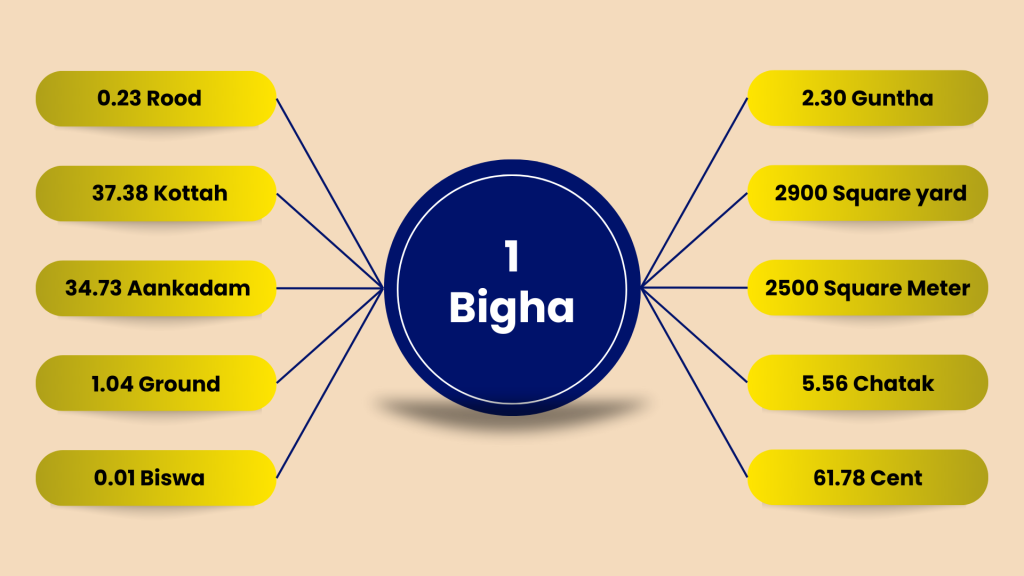Bigha is a traditional unit of measurement used in parts of India, Bangladesh, and Nepal. It is mainly used to measure land area and can range anywhere from 0.3 acres to 3 acres, depending on the area in which it is used. It’s an important tool for farmers in the region, as it helps them determine the size and productivity of their land.
It is a great way to compare different cultivable lands, as properties of the same size may have different yields depending on the soil type and other factors. Bigha is also used to calculate tax rates and ownership of agricultural land in India, Bangladesh, and Nepal. In many parts of India, all these details about the land like the type of land, size, etc. are mentioned in the Khatian.
What is Bigha?
What is Bigha?
Bigha is a traditional unit of land measurement found mainly in the Indian Subcontinent and some parts of Bangladesh, Nepal and Pakistan. Bigha is a traditional unit of measurement and is roughly equal to 1/3rd of an acre or 0.3 hectares. Bighas vary in size depending on the region and may range from one-third of an acre to more than two acres.
It is believed to be a Hindi term derived from the term Bigha which is the Sanskrit term for this unit of measure. Bigha varies in size from region to region. The term “row house” is often used interchangeably with “townhouse” in some regions.
In India, 1 Bigha equals about 0.676 hectares and in Nepal, 1 Bigha equals about 0.314 hectares. It is generally used for the measurement of agricultural land, although it may also be used for residential plots.
History of Bigha in India
History of Bigha in India
The term Bigha is derived from the traditional unit of measure in India, and it is typically used to measure land area. The history of Bigha in India dates back centuries. In the past, Bigha had different definitions in different regions and states of India, with some states having a larger Bigha than others. The exact size of a bigha varies depending on the region.
What Is Prohibited Property: Everything You Need to Know
In the North of India, a bigha is generally defined as equal to 1,000 square yards, while in the South it is usually divided into 20 agendas. Historically, bighas were used to measure the size of a plot of land. In the modern era, the term is still in use in many Indian states. In some places, the measurement is still used for taxation purposes. Despite being a traditional way of measuring land area, bigha is still applicable today in India.
Today, Bigha is standardized in India and is officially defined as equal to 0.3 hectares, or 1/3 of an acre. The standardized Bigha is used for land transactions and taxation purposes throughout India. But still, some part of India doesn’t use Bigha, and different cities like tier 1 2 3 cities in India have different measurement and unit of the 1 Bigha.
At the time of tax deduction Home loan gives the benefit of tax saving. So get the best home loan rates and start investing in the property.
Get the Best Home Loan Rate at PropertyCloud
List of Indian states where Bigha is used
Zone | States |
East India | Assam, Bihar, West Bengal, Jharkhand |
West India | Gujarat |
Central India | Madhya Pradesh |
North India | Haryana, Punjab, Rajasthan, Uttar Pradesh, Himachal Pradesh, Uttarakhand |
Conversion table for Bigha in Square Feet in different States
State | 1 Bigha |
Assam | 14,400 Square Feet |
Bihar | 27,220 Square Feet |
West Bengal | 14,348.29 Square Feet |
Jharkhand | 27,211 Square Feet |
Gujarat | 17,427 Square Feet |
Madhya Pradesh | 12,000 Square Feet |
Haryana | 27,225 Square Feet |
Punjab | 9,070 Square Feet |
Rajasthan | 27,225 Square Feet (Pucca Bigha) 17,424 Square Feet (Kuchha Bigha) |
Uttar Pradesh | 27,000 Square Feet |
Himachal Pradesh | 8,712 Square Feet |
Uttarakhand | 6804 Square Feet |
What Is R-zone in Maharashtra: Everything You Need to Know
Bigha to other units

1 Bigha to Square Feet, Acre, Hectare in different states
State | Square Feet | Acre | Hectare |
Assam | 14,400 | 0.3306 | 0.13 |
Bihar | 27,220 | 3.025 | 0.01264 |
West Bengal | 14,348.29 | 0.33 | 0.133 |
Jharkhand | 27,211 | 3.02 | 0.25 |
Gujarat | 17,427 | 0.4 | 0.16 |
Madhya Pradesh | 12,000 | 0.27 | 0.2529 |
Haryana | 27,225 | 0.25 | 0.10117 |
Punjab | 9,070 | 0.25 | 0.10117 |
Rajasthan | |||
1 Pucca Bigha | 27,225 | 0.625 | 0.25 |
1 Kuchha bigha | 17,424 | 0.4 | 0.1618 |
Uttar Pradesh | 8,712 | 0.2 | 0.08090 |
Himachal Pradesh | 6,804 | 0.2 | 1.52 |
Uttarakhand | 27,000 | 0.625 | 0.25 |
Bigha in other countries
A bigha is a traditional unit of area that is used in many countries, including India, Bangladesh, Nepal and parts of Pakistan. It is an ancient measure of land, and its exact size has varied over the centuries. Generally, it is considered to be a measure equivalent to 0.3 to 1.6 acres. some sources have argued that in India, it is equivalent to 0.67 acres. In Nepal, one bigha is roughly equal to 0.33 acres.
The origin of the term bigha is uncertain, but it is believed to have originated in a medieval Indian system of measurement. As the Indian population grew, so did the need for more precise measurements of land, and the bigha became a standard unit of measurement.
In India, the bigha was a popular unit of measurement until the 1950s when the nation began transitioning to the metric system. Despite that, the bigha continues to be used in rural parts of India, as well as in some other countries, particularly in South Asia. When considering property dimensions, individuals often refer to ancient measurements like bigha, aligning with cultural practices and beliefs such as the significance of seven horse painting vastu in traditional Indian architecture and design.
In Bangladesh, a bigha is equal to 0.3 acres and is the official unit of measurement there. The bigha is also used as a unit of measurement in Pakistan, and it is the traditional unit of area in some parts of Afghanistan. In addition, it is used in Nepal, where it is equivalent to 0.33 acre.
Although the bigha is gradually being replaced by the metric system, it is still a common unit of measurement in many parts of the world. Its legacy continues to be seen in many areas, and it will likely remain an important part of the culture of these countries for many years to come.
Top 10 Fastest Growing and Emerging Cities in India You Must Keep On Your Watchlist
How to convert Bigha into different units?
Example 1
If 1 Bigha is 14,400 Square Feet in Assam and you need to convert 1523 Bigha into Square Feet, then the calculation will be:
14000 (1 Bigha in Sq.Ft.) * 1523 (Total Bigha)
Then the answer is 21,322,000 Sq.Ft.
Example 2
If 1 Bigha is 0.25 Acre in Punjab and you need to convert 1840 Bigha into Acre, then the calculation will be:
0.25 (1 Bigha in Acre) * 1840 (Total Bigha)
Then the answer is 460 Acres
Example 3
If 1 Bigha is 0.133 Hectares in West Bengal and you need to convert 1355 Bigha into Hectare, then the calculation will be:
0.133 (1 Bigha in Hectare) * 1355 (Total Bigha)
Then the answer is 180.215 Hectares
Bigha: The oldest and traditional land measurement unit
A Bigha is a traditional unit of measurement in various parts of the world, including India, Nepal, Bangladesh, and parts of Pakistan. It is typically used to measure the area of land for agricultural or residential purposes. The exact size of a bigha varies from country to country and region to region. In recent years, its use has spread to other countries, such as the United States, where it is used to measure land for farming and residential purposes. Over the years, its use has evolved, and it is now widely used as a common unit of measurement in agricultural and residential land transactions. Some of the Smart Cities are also using Bigha for land measurement in India.
In India, the distinction between kuccha house and pucca house is crucial in the realm of real estate. You can construct a kutcha house on a plot of land, including land measured in bighas. A kutcha house typically refers to a structure made from less durable and temporary materials such as mud, thatch, bamboo, or other locally available resources. These houses are often constructed in rural areas or for temporary shelter purposes, representing a traditional and historical aspect of Indian housing. In contrast, a pucca house signifies a permanent and solidly constructed dwelling made from durable materials like bricks, cement, and concrete, offering stability and long-term habitation. Understanding this distinction is vital when evaluating properties in diverse regions of India.

I’m a Digital Marketing Executive and a Content Writer at PropertyCloud. Passionate about crafting compelling, concise, and reader-friendly content. I am dedicated to delivering the best possible experience through words from the past few years.










